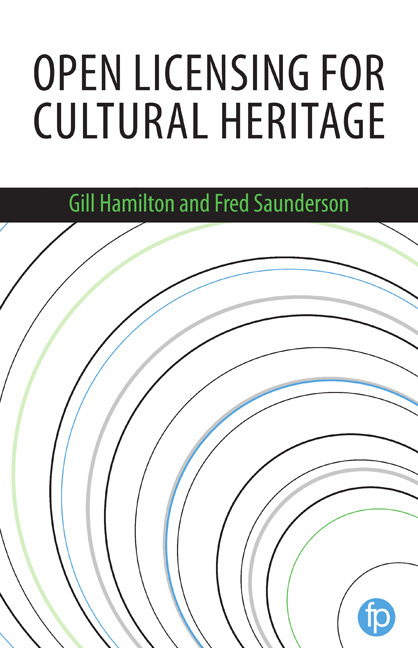Book contents
- Frontmatter
- Contents
- List of figures and tables
- Acknowledgements
- About the authors
- 1 Introduction
- 2 The open movement: its history and development
- 3 Copyright and licensing: a background
- 4 Open licensing: the logical option for cultural heritage
- Introduction to case studies
- 5 Small steps, big impact – how SMK became SMK Open
- 6 The British Library experience of open metadata licensing
- 7 Open policy and collaboration with Wikimedia at the National Library of Wales
- 8 Newcastle Libraries – the public library as a place to share culture
- 9 Developing open licensing at the National Library of Scotland
- 10 The Wellcome Library
- 11 Developing an open educational resources policy and open approaches to mitigate risk at University of Edinburgh
- 12 How to implement open licensing
- 13 Using and reusing openly licensed resources
- 14 Conclusion
- Index
12 - How to implement open licensing
Published online by Cambridge University Press: 08 June 2018
- Frontmatter
- Contents
- List of figures and tables
- Acknowledgements
- About the authors
- 1 Introduction
- 2 The open movement: its history and development
- 3 Copyright and licensing: a background
- 4 Open licensing: the logical option for cultural heritage
- Introduction to case studies
- 5 Small steps, big impact – how SMK became SMK Open
- 6 The British Library experience of open metadata licensing
- 7 Open policy and collaboration with Wikimedia at the National Library of Wales
- 8 Newcastle Libraries – the public library as a place to share culture
- 9 Developing open licensing at the National Library of Scotland
- 10 The Wellcome Library
- 11 Developing an open educational resources policy and open approaches to mitigate risk at University of Edinburgh
- 12 How to implement open licensing
- 13 Using and reusing openly licensed resources
- 14 Conclusion
- Index
Summary
Introduction
The previous chapters and case studies have explained and demonstrated the need for, and benefits and challenges of, using open licences. We hope you are now convinced that open licensing is a viable proposition for encouraging the use and reuse of your organisation's resources. In this chapter we will take you through the steps necessary to implement open licensing: making the case to your senior managers, developing a policy and implementing it, and creating a sustainable open licensing environment.
How to make the case for open licensing
This first section explains how to begin the licensing process for organisations that have no established approach to licensing, open or otherwise. This is not only about making the case for open licensing, but above all about understanding your need for licensing, your licensing goals, and your organisation's willingness and appetite to engage with open licences in order to reach those goals. There are five steps involved in this process:
• Clarify your context.
• Obtain senior management buy-in.
• Express your vision and goals.
• Outline relevant licensing options.
• Document the decision.
Clarify your context
This step establishes context by surveying and noting the parameters that directly influence your decision to adopt an open licensing policy. As a first step to establishing any form of licensing approach or policy, open or otherwise, it is vital to identify, understand and capture your context. For open licensing by cultural heritage organisations, this most likely involves surveying and noting:
• the types of licensable material you have, especially identifying complex forms of material
• your user profile
• your organisational profile and strategy
• external limitations.
Identify types of licensable material
You need primarily to understand the types of licensable material your organisation has. All cultural heritage organisations have licensable material of one form or another. Establish how much licensable material your organisation has in broad terms. It is not necessary to develop a precise count of the number of licensable objects you hold. Rather, you should attempt to understand the types of licensable material your organisation holds and where within your organisational structure this material is located and cared for.
- Type
- Chapter
- Information
- Open Licensing for Cultural Heritage , pp. 167 - 192Publisher: FacetPrint publication year: 2017



